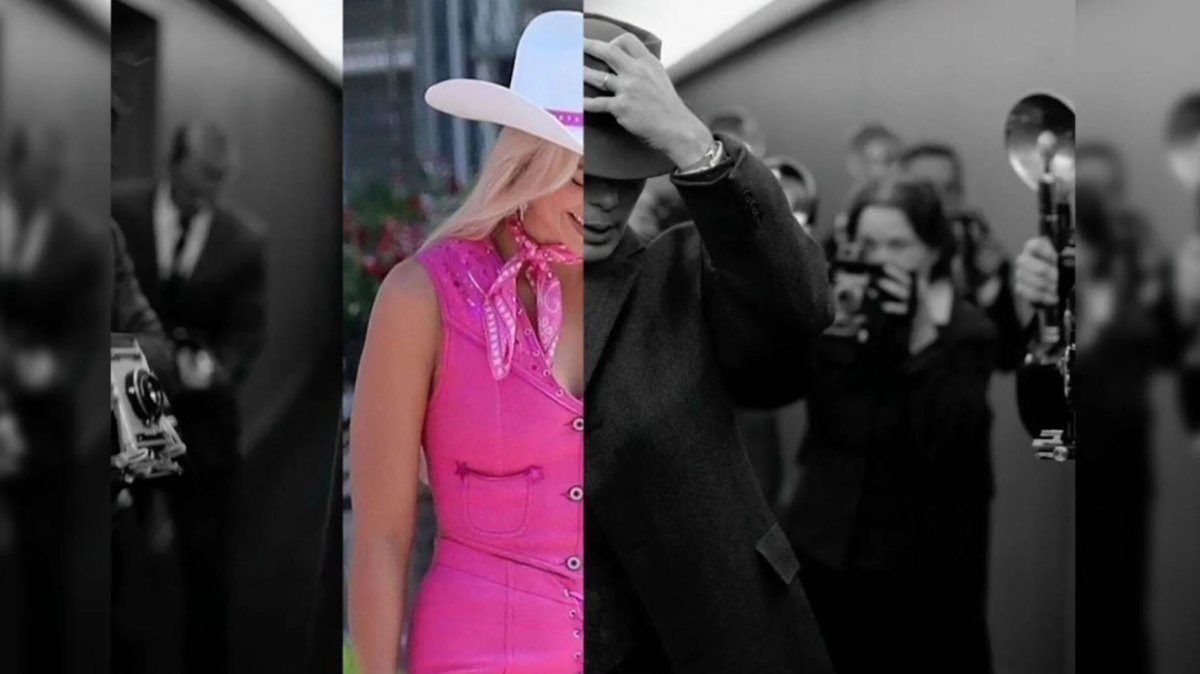Movie theaters were flooded on July 21 with people dressed head to toe in early 20th-century business attire and hot pink dresses, tops and skirts. The phenomenon marked the releases of “Barbie” and “Oppenheimer” on the same day, and has become known as “Barbenheimer.”
“Barbie” is a film directed by Greta Gerwig starring Margot Robbie, Ryan Gosling and other decorated actors, forming a star-studded cast. The movie follows Barbie (Robbie) in Barbieland, a world where women run it all, and men simply blend into the background. However, a crisis leads Barbie, followed by Ken (Gosling), to venture into the real world.
In the real world, Barbie realizes that the messages the doll aims to project, such as female empowerment and equality, are lost on humans. In reality, the doll is projecting the opposite message, one of the unrealistic beauty standards and misogynist ideals. To make things worse, Ken is exposed to the patriarchy and brings it back to Barbieland. What will the dolls do?
Barbie is a fun movie that is layered with important themes and debates, and, to top it off, has generated $1.388 billion, according to Google.
“Oppenheimer” is, to an extent, almost the opposite of “Barbie.”
The Christopher Nolan-directed drama/thriller which is based on real historical events, stars Cillian Murphy as J. Robert Oppenheimer, the father of the atomic bomb. Alongside a highly renowned cast with names like Florence Pugh, Robert Downey Jr., Emily Blunt and Matt Damon, the film discusses Oppenheimer’s background and how he became the inventor of the bomb, following his university years, teachings and involvement in the Manhattan Project. The movie has produced about $853 million at the box office so far, according to EuroNews.
Both movies gripped the internet for months in advance, with memes depicting black and pink houses together and trends applying the idea of contrasting monochromatic and colorful themes. Were the movies worth the sensation their release provoked? Here are my thoughts.
“Barbie” Review
“Barbie” was a 7/10. The movie was good, the acting was engaging and the plot was well thought-out. However, it seemed as though, while the movie does mention some problems facing society, it does not explore them with much depth. Sexism, patriarchy and misogynism are all addressed, normally in a humorous way, but the movie does not seem to truly reflect on them or explain their impact.
Additionally, can one movie reverse the damage that the Barbie doll has done? For me at least, whenever I think of Barbie I think of the stereotypical, thin Barbie, who in my mind was everything I did not want to be as a woman. Will one movie change that perspective?
While the movie is centered on Barbie, Ken does play an important role, especially with hints at toxic masculinity that men face on a daily basis. Yet again, these themes that are so significant seem to be brushed over. The idea of being “Kenough” (i.e. that Ken is enough without Barbie) did not seem fleshed out enough nor as significant as it should be.
Lastly, the ending scene where Barbie holds her creator’s hand, and sees visions of the past from a very motherly perspective to me was a bit contrary to the entire message of the movie. It could arguably have been more impactful to have flashes of what women will face in the real world: success, but also obstacles, such as unrealistic standards.
Gerwig, however, did produce a successful movie, and she herself advocated to make sure the messages she wanted projected were addressed in the movie. With movies like “Lady Bird” and “Little Women” under her belt, this non-stereotypical Barbie left audiences crying and laughing while rethinking all of society. Another notable shoutout goes to America Ferrera, whose character’s monologue about womanhood ought to be studied in English classes.
All in all, Barbie was a fine movie, with critical themes addressed, but seemingly underdeveloped, leading me to give it a 7/10 (also, Allan deserved more screen time).
“Oppenheimer” Review
“Oppenheimer” was a 9/10. One major sign of a good movie is when it is three hours long, but feels like one. Nolan’s cinematography is incredible, combining black and white with color in order to attract the audience through subjective and objective memories. These details, which are done without CGI, offer a captivating view of the early 20th century and the historical context of the development of the atomic bomb.
There are no words to describe the two pivotal scenes of the movie. The first was right after the drop of the atomic bomb. The silence, as well as the tortured screams of the innocent civilians in Hiroshima while Oppenheimer stares blankly at the cheering faces of American families, leave the audience grim with goosebumps running down their arms.
As if the tension of that scene was not enough, the ending scene, a brief interaction between Oppenheimer and Einstein, leaves the audience reeling, wondering about the implications of the atomic bomb. In the now-famous scene, Oppenheimer asks if Einstein remembers when he brought him those calculations of the possibility that the bomb would yield a never-ending reaction that would cause the atmosphere to explode. Einstein says yes and asks why Oppenheimer is asking him about it. Murphy’s piercing blue eyes later utter the words that leave audiences glued to their seats, “I believe we did.”
Murphy’s transmission of the message that the creation of the atomic bomb has led to an infinite reaction whose consequences are still being seen was a scene I will never forget, nor will most. But Murphy is not the only actor who transmits such power and commitment to his role. Blunt, who plays Kitty Oppenheimer, Damon, who plays General Leslie Groves and Pugh, who plays Jean Tatlock, also create and bring life to their characters in vivacious and awe-inspiring ways.
Robert Downey Jr. also deserves a notable mention, as he carries the whole movie. Downey, who plays Lewis Strauss, the former acting United States Secretary of Commerce, brings an unusual ominousness to the role, a stark contrast to his typical egotistical, bubbling characters, like Iron Man or Sherlock Holmes. The performance keeps audiences entranced and is thus the final piece of the 9/10 review.
While “Oppenheimer” won the “Barbenheimer” battle for me, both movies are unique in their own ways and are worth watching. At the end of the day, they are drastically different, one being rooted in fiction and aimed at younger audiences, and the other aiming to capture one of history’s and science’s most pivotal moments.
So, as we all dress up in black suits and ties or pink dresses and skirts, I would like to ask you: who wins the “Barbenheimer” battle for you?
By Elektra Geasereti







































































